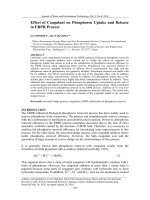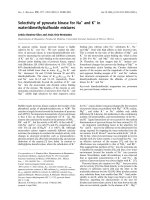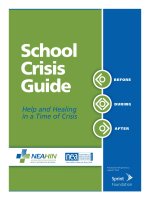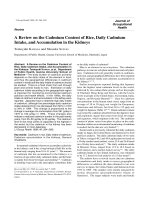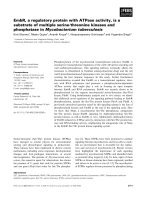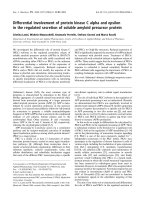- Trang chủ >>
- Khoa Học Tự Nhiên >>
- Vật lý
beyond the roof of the world music prayer and healing in the pamir mountains nov 2008
Bạn đang xem bản rút gọn của tài liệu. Xem và tải ngay bản đầy đủ của tài liệu tại đây (2.55 MB, 238 trang )
Beyond the Roof
of the World
This page intentionally left blank
Beyond the Roof
of the World
Music, Prayer, and Healing
in the Pamir Mountains
benjamin d. koen
New York
2009
Oxford University Press, Inc., publishes works that further
Oxford University’s objective of excellence
in research, scholarship, and education.
Oxford New York
Auckland Cape Town Dar es Salaam Hong Kong Karachi
Kuala Lumpur Madrid Melbourne Mexico City Nairobi
New Delhi Shanghai Taipei Toronto
With offi ces in
Argentina Austria Brazil Chile Czech Republic France Greece
Guatemala Hungary Italy Japan Poland Portugal Singapore
South Korea Switzerland Thailand Turkey Ukraine Vietnam
Copyright © 2009 by Benjamin D. Koen
Published by Oxford University Press, Inc.
198 Madison Avenue, New York, New York 10016
www.oup.com
Oxford is a registered trademark of Oxford University Press
All rights reserved. No part of this publication may be reproduced,
stored in a retrieval system, or transmitted, in any form or by any means,
electronic, mechanical, photocopying, recording, or otherwise,
without the prior permission of Oxford University Press.
Library of Congress Cataloging-in-Publication Data
Koen, Benjamin D.
Beyond the roof of the world : music, prayer, and healing in the Pamir mountains /
Benjamin D. Koen.
p. cm.
Includes bibliographical references and index.
ISBN 978-0-19-536774-4
1. Healing—Pamir Mountains Region. 2. Spiritual healing—Pamir
Mountains Region. 3. Holistic medicine—Pamir Mountains
Region. 4. Music therapy—Pamir Mountains Region. 5. Prayer—
Pamir Mountains Region. I. Title.
[DNLM: 1. Music Therapy—Tajikistan. 2. Holistic Health—Tajikistan.
3. Medicine, Tibetan Traditional—Tajikistan. 4. Spiritual Therapies—
Tajikistan. WB 550 K78b 2008]
R733,K582 2008
615.8′5209586—dc22 2007037165
1 3 5 7 9 8 6 4 2
Printed in the United States of America
on acid-free paper
For Saba,
Naseem, and Solya
This page intentionally left blank
Acknowledgments
To acknowledge befi ttingly all those who have contributed to this
project, to its spirit and substance, and who have enthusiastically
supported and encouraged its author, would indeed be impossible.
I must, however, express my deep gratitude to the following people,
each of whom has contributed in a special way to the completion of
this work and enriched me personally: the countless musicians and
newly found friends and associates in Tajikistan—particularly in
Pamir, Samandar Pulodov for his brotherhood, mystical insight and
calm communication, expertise and tireless assistance in the fi eld;
Davlatnazar for his masterful driving through treacherous moun-
tain passes and over raging rivers, his sense of humor and positive
nature; nurse Lailo and Dr. Shirinbek, both of whom helped to fl esh
out aspects of the medical dimension of the project in Badakhshan;
Rafi que Keshavjee and all the friends at the Aga Khan Humanities
Project for their hospitality and assistance in welcoming my wife and
me to Tajikistan and facilitating our work; and Margaret Mills for
introducing me to new friends and colleagues in Dushanbe.
I also extend my gratitude to numerous colleagues across the
fi elds of music, medicine, the humanities, and sciences, who have
encouraged this work, especially Margarita Mazo, Ted Levin, Daniel
Avorgbedor, William Malarkey, Marina Roseman, Kay Kaufman-
Shelemay, Gregory Barz, Ken Brummel-Smith, Karen Brummel-
Smith, and Michael Rohrbacher. I also offer my heartfelt thanks to
the following people: to all my Persian-speaking family, friends, and
viii acknowledgments
colleagues who continually share their knowledge of Persian with me, and
many of whom assisted in translating some of the Tajik-Persian language texts
that underlie much of this study, especially my mother-in-law, Mahin Vojdani,
Dick Davis, and Parvaneh Pourshariati; to Shiling Ruan for assistance with the
statistics; and Suzanne Ryan for her intellectual courage and excellence in her
work. I am also honored to acknowledge and thank my brother, Joseph Koen,
for his loving encouragement, advice and consultation regarding the medical
and neurological aspects and implications of my research; and to my parents
Thelma and Leon Koen for their unfailing and unconditional love, strength,
and encouragement, and their example of sincerity, integrity, and trustworthi-
ness. Most of all I thank my beloved wife and best friend, Saba Koen, who
shared in these and so many other experiences of music, prayer, meditation,
and healing in and beyond the roof of the world, for all that we have shared,
and all the journeys yet to come; and to our children Naseem and Solya, who
are a constant example of the miracles of life and the joys of an open mind and
free spirit.
Contents
Language, Pronunciation, and Transliteration, xi
1. Medical Ethnomusicology and the Ontology of Oneness , 3
2. The Five Factors of Music, Prayer, Health, and Healing, 25
3. Music–Prayer Dynamics and Cognitive Flexibility, 59
4. Soundscape and Musical–Spiritual Entrainment , 93
5. Healthscape, Mystical Poetry, and Multimodal Healing , 123
6. Transformative Meaning in Sound, Empowered Sound
in Culture , 153
7. Human Certainty Principle, of Science, Spirituality,
and Experience , 181
Notes , 205
References , 213
Index , 221
This page intentionally left blank
Language, Pronunciation,
and Transliteration
The Persian language is the mother tongue of Iran, Tajikistan, and
Afghanistan. Note that “Persian,” not “Farsi,” is the correct name for
the language when speaking in English. “Farsi” is the transliteration
of the Persian word for the language. In English, the national lan-
guage of Tajikistan is commonly referred to as Tajik, Tajik-Persian, or
Persian. In the language itself, it is called Tâjiki or Fârsi. To indicate
the closest pronunciation of the Tajik-Persian found in this text, I
employ the basic transliteration system found in Lewis (2000, xvii),
which is straightforward for the English reader.
Vowel Sound
a lab
â law
e bed
i machine
u tutu
o go
xii language, pronunciation, and transliteration
Consonant Sound
kh Bach (German) or José (Spanish)
zh vision
The “â” sound in Tajik lies in between the sound found in “law” and that
of “go,” whereas in the standard Persian spoken in Iran, it is most often pro-
nounced as the sound of “law.” The “gh” and “q” represent sounds not found in
English, a hard velarized “g” pronounced higher up in the mouth” (Lewis, 2000,
xvii). Many authors often use the French “r” as a reference, which serves as a
good starting point, however, the intended sound is quite distinctive and unlike
the French “r.” To pronounce the Tajik-Persian (or Persian) “gh” or “q,” a helpful
comparison can be made with the pronunciation of the English “g.” To pro-
nounce “g” (as in “gap”), one makes contact with the middle of the tongue to the
point where it meets the soft palette; the tongue disallows airfl ow until the point
of contact is released, thus producing the sound “g.” With the same process in
mind, rather than using the middle of the tongue, one should use the area that
produces the French “r,” the back of the middle velar region, which must make
contact with the palette so that there is no possible airfl ow. When this point of
contact is released, the proper sound is produced. One must have the “gh” or “q”
sound in mind, or a hard “k” sound might be produced. Other consonants are
basically consistent with their English equivalents. Plurals in Persian are gener-
ally created by the addition of ân, ât, or hâ on the end of a word. For simplicity
and clarity, I have opted to use “-s” to indicate plural forms.
Beyond the Roof
of the World
This page intentionally left blank
1
Medical Ethnomusicology
and the Ontology
of Oneness
He drew a circle that shut me out—
Heretic, rebel, a thing to fl out.
But Love and I had the wit to win:
We drew a circle that took him in!
—Edwin Markham
The healing powers arising from the mystical intercourse of music
and prayer have captured the attention of prophets and poets, scien-
tists and physicians, the lay and the learned alike throughout the ages
and across the world. In the present global-cultural milieu, where
professional, affordable healthcare is scarce at best for the majority
of humanity, where a staggering number of people in the wealthi-
est country of the world are without basic health insurance, where
medical mistakes have become far too numerous, and where an
increasing number of individuals are opting for ICAM (integrative,
complementary, and alternative medicine) approaches to health care,
much can be learned from cultures that have ancient traditions of
ICAM healing. The Pamir Mountain region of Tajikistan is one such
cultural area, where the local worldview and physical landscape have
allowed the musical, religious, spiritual, and scientifi c domains of
knowledge to remain connected, often for the common goal of heal-
ing, rather than being separated into diametrically opposed boxes of
human understanding and experience—usually compartmentalized
as “science,” “religion and spirituality,” and “music and the arts.”
4 beyond the roof of the world
While it is still overwhelmingly true that “in the West, music simply is not part
of the biomedically driven clinical reality encountered in doctors ’ offi ces, clin-
ics, and hospitals” (Friedson 1996, xi), the last decade has seen a new degree of
interest and openness on the part of physicians, scientists, and funding institu-
tions to support and conduct research that considers music, prayer, meditation,
and related practices as potentially effi cacious medical and psychological inter-
ventions for use in clinical and public health settings. This broad-based interest
includes a deeper awareness that spirituality and belief are essential to include
in the outmoded mind-body description of a human being.
Across diverse cultures, musical healing is practiced within the context of
broader belief systems and religions, which often function as holistic entities.
Friedson observes, for instance, that “in traditional African societies, religion
and healing form an amalgam that is often functionally irreducible into constit-
uent parts” (Friedson 1998, 274). Throughout traditional cultures of the world,
music is almost always central to healing, and is viewed as being essentially
spiritual or “other worldly.” Additionally, a common etiological view among
practitioners in traditional healing systems is that “any illness is . . . ascribed
to a disturbance of the balance between man and spiritual or mystical forces,
and the aim of health seeking is to restore the equilibrium” (Oosthuizen 1989,
30). Music is often described as the bridge by which the physical and spiritual
are connected and can be the most vital component of a healing ceremony
or practice. Moreover, the physical and spiritual dimensions are often viewed
not as separate dimensions that must be connected but, rather, as aspects of
one reality, where music functions as a balancer of these aspects, facilitating
and contextualizing the ritual performance of healing that occurs through the
interaction of physical, spiritual, and musical forces.
Establishing a balance of the physical and spiritual, however, is not only a
central concern in cultures where traditional or indigenous knowledge is in-
tegral to life; it is of profound importance to countless individuals in the most
technologically developed countries of the world. It is for this very reason that
ICAM is dramatically increasing. Developments in ICAM, many concepts, ap-
proaches, and techniques of which emerge from or are related to traditional
practices, imply a fundamental change in the understanding of health and
what comprises a human ’s being, which can no longer be described in strictly
biological, material, or mechanistic terms. The ICAM movement aims “to
shift some of the basic orientations of medicine: toward healing rather than
symptomatic treatment, toward a closer relationship with nature, toward a
strengthened doctor-patient relationship and an emphasis on mind and spirit
in addition to body” (Weil 2000, 442). Furthermore, it recognizes humans
as empowered with the natural capacity to heal, given the proper context of
medical ethnomusicology and the ontology of oneness 5
being— holistically viewed as inclusive of the biological, psychological, social,
emotional, and spiritual dimensions of life.
There is a growing interest in integrative approaches to health and healing
among academic and popular sectors of society, as well as an increased use of
complementary and alternative treatments by the general public in places where
biomedicine is the norm (Levin 1997; Astin 1998). A corollary to this is the
increase and development of course offerings on complementary methods in
medical schools in the United States (Wetzel et al. 1998). Concurrently, there is
an increased interest in spirituality and religion (Levin 1997) that links directly
with the public and academic interest of including aspects of spirituality and re-
ligiosity in medicine (Larson and Larson 1994; Larson et al. 1998; Koenig 1997).
Moreover, patients feel that “technology is not enough . . . [they] want something
more, something that goes beyond the proper functioning of the physical body”
(Dossey 1999, 18). Indeed, the central theme in the broad discourse within and
around ICAM is that the proper functioning of the physical body does not, and
cannot exist in a vacuum, and must include the individual ’s assessment of a
condition, belief, spirituality, emotional, and psychological states. As the placebo
and nocebo effects, biofeedback, psychoneuroimmunology, modern physics, as
well as the miraculous cures and spontaneous healings that are documented
throughout the history of medicine have overwhelmingly shown, there can be
an effi cacious relationship between the tangible and intangible—between be-
lief, consciousness, the metaphysical, and the body.
1
An important institutional
response to this expanded awareness has been the formation of the National
Center for Complementary and Alternative Medicine (part of the NIH) in 1998.
This center funds research in various areas, which have parallels in diverse cul-
tural contexts of music and healing, including prayer, dance, psychotherapy, im-
agery, hypnosis, and meditation.
A critical addition to the discourse, which has yet to be brought to the
forefront, even though it shapes all healing experiences, is the laden frame
of cultural context— the dynamic, multidimensional spaces and places where
music and related praxes are empowered with cultural and personal meaning
to promote health and facilitate healing. This is but one area in which medi-
cal ethnomusicology strengthens the course of integrative medicine. In addi-
tion, medical ethnomusicology brings a wealth of diverse healing practices and
in-depth knowledge of music and sound phenomena to bear within the ever-
present and ever-changing frame of culture.
The inclusion and utilization of both the physical and spiritual re-
alms in healing has been described as a “sacred clinical reality” (Kleinman
1980, 241), which builds on the socially and culturally informed concept of
“ clinical reality”—or a complex of interrelated features including “the beliefs,
6 beyond the roof of the world
expectations, norms, behavior, and communicative transactions associated with
sickness, health care seeking, practitioner-patient relationships, therapeutic ac-
tivities, and evaluation of outcomes” (Kleinman 1980, 42). Building from this
framework, healing systems or clinical realities oriented toward that which is
spiritual, religious, or metaphysical “emphasize sacred reality, illness orienta-
tion (meaning that they take into account the patient ’s account of the problem
as their central concern), symbolic intervention, interrogative structure, family
centered locus of control . . . and substantial expectation of change, even cure”
(Kleinman 1988, 120). Through an in-depth exploration of one such sacred
clinical reality from the heart of the Pamir Mountain region of Badakhshan,
Tajikistan, and further illustrations drawn from diverse experiences outside of
Pamir, this book illuminates a constellation of culture-transcendent principles
and processes that underlie diverse practices of healing across world cultures.
Movements in the Field
As a work positioned within the ICAM discourse and at the intersections of
medical, cognitive, and applied ethnomusicology, this book moves in new direc-
tions beyond the conventions of the discipline of ethnomusicology in two im-
portant ways. First, the study connects ethnomusicology and health science by
employing an integrative methodology of physiological experiments in the con-
text of ethnographic fi eld research in Pamir, during which time I often engaged
in a collaborative research approach in which I worked with local medical doc-
tors and traditional healers in the fi eld to explore multimodal practices of musi-
cal and spiritual healing. This approach, in part, aims to provide a more holistic
perspective of sacred clinical musical healing experiences, and encourages inte-
grative and collaborative approaches across disciplinary borders. Second, this
book suggests that the culture-transcendent principles and processes explored
here can be relevant to one ’s own life, and our contemporary world. I should
emphasize that while some may view this to be a bold or challenging statement,
it is not intended to be so. Rather, I view this as an unfolding expression of an
outward-looking orientation that is growing in ethnomusicology and academia
as a whole. This outward-looking orientation results from an aspiration to do
work of value, import, and of benefi t to others, which, while a central concern to
many in the discipline, is especially strong among the new generation of young
scholars, who are keenly focused on and passionate in their concern for mak-
ing contributions in three core areas. First, they hope to serve and benefi t the
people in the cultures where they conduct their research; second, they endeavor
to advance ethnomusicological knowledge and that of related disciplines; and
medical ethnomusicology and the ontology of oneness 7
third, free from the circumscription of disciplinary borders, social constructs, or
conventions, through their research and practice, they aspire to contribute to the
lives of people beyond their immediate cultural area of research.
These aspirations are, in part, what initially drew me to ethnomusicology,
and what have compelled several scholars to pursue applied research in the
medical ethnomusicology realm. Certainly, it cannot be said that these three
points are new and only of interest to the younger generations of ethnomu-
sicologists and colleagues in related fi elds of study and applied practice. On
the contrary, these motivations, along with an inherent love for people and
music, have oft been the direct or underlying impetus that has inspired many
a heart and mind throughout the history of ethnomusicology. I highlight these
three points here because they form a sense of primacy that compels many in
our disciplines to conduct research that is not only meaningful and relevant to
one ’s self and the culture from which it emerges, but also to people beyond that
particular cultural milieu.
In hand with these concerns is an ontological sensibility that uniquely
shapes how many younger generation ethnomusicologists view themselves and
those with whom they work in the fi eld. Fortunately, like their predecessors, this
generation is by no means uniform. Nevertheless, the sociocultural changes of
the last quarter century have not only created a unique global awareness and
opportunity for engagement among the peoples of the world that was not as
typical or possible previously but also have shaped the processes of accultura-
tion and academic training of these scholars, making them keenly aware that
they are intimately linked to and part of the whole of humanity, which, for
those who engage cultural domains as central to their research, comprises the
broadest sociocultural frame of life on the planet. Simultaneously, there is a
growing awareness that each individual comprises a unique cultural landscape
that might or might not share certain aspects with the broader surrounding
and overlapping cultural frames of meaning that range from a relationship
between two people and extend to humanity as a whole. This ontological sen-
sibility is unique in the way that it further engenders respect and cultural
sensitivity for individuals and cultural groups, on the one hand, and, on the
other hand, simultaneously imbues a person with a sense of belonging to the
whole—a sense that is not dependent on sameness for belonging to be real.
Rather, difference or variation, whether it is in physical form, belief, behavior,
or temperament, is viewed as a function and expression of the infi nite strands
of individual diversity of the whole, not a way to separate people into categories
of opposition.
Exploring the tension between different ontological frames and the physi-
cal universe, which in part, facilitates different degrees of the experience of
8 beyond the roof of the world
wholeness or fragmentation, the physicist David Bohm draws attention to the
dynamic between what he calls the “implicate order,” which gives rise to the
manifest or “explicate order” in the universe (Bohm 1980). He shows how
one ’s awareness and understanding of the common ground between matter
and consciousness brings forth an experience and reality directly representa-
tive of that particular awareness and understanding. If attention is given only to
the divided and fragmented explicate order, “an illusion may arise in which the
manifest static and fragmented content of consciousness is experienced as the
very basis of reality and from this illusion one may apparently obtain a proof
of the correctness of that mode of thought in which this content is taken to
be fundamental reality” (Bohm 1980, 262), thus divorcing one ’s consciousness
from the underlying “wholeness of the implicate order.” For instance, the long-
standing false notion of an essential dichotomy between the mind and body can
be seen as the result of attention to what might appear as separate and unrelated
parts of a human being, rather than viewing them as aspects of one whole. In
relation to this, Varela, Thompson, and Rosch suggest, “Descartes ’ conclusion
that he was a thinking thing was the product of his question, and that question
was a product of specifi c practices—those of disembodied, unmindful refl ec-
tion” (Varela et al. 1991, 28). Their thesis, which is, on many points, expressive
of Bohm ’s technical and philosophical argument, and that encourages a balance
between what they call “two planetary forces, science and Buddhism” (Varela
et al. 1991, 254), intersects with the present book in many ways.
This book is also concerned with a harmony between multiple domains of
knowledge—science, religion, spirituality, belief, culture, music, and experience—
and approaches ways of knowing and ways of healing as being centrally connected to
transformative experiences in which multiple types of music, prayer, and medita-
tion are key for embodying a state of being that is expressive of wholeness and
health. Another shared aspect is that Varela, Thompson, and Rosch are also con-
cerned with making a positive difference in the world that is not confi ned to con-
tributing knowledge to “their” area of cognitive science alone, but seeks to appeal
to a readership that might engage mindfulness awareness as a way of enacting a
better world.
These formulations in physics (Bohm 1980) and cognitive science (Varela
et al. 1991) are mentioned here to give a broader purview of the ontological
sensibility that is growing within academia, which informs the younger
generation of ethnomusicologists ’ lifeworlds, and that categorically shifts
former presumptions based on separateness and otherness to connectedness
and wholeness.
This ontological shift also has important implications for ethics in the fi eld.
While this ontology engenders an increased respect for the diversity of another
medical ethnomusicology and the ontology of oneness 9
human being or culture, there is a corollary increased sense of belonging or
shared existence on the planet that allows for a more intimate and transparent
engagement and discourse between all participants in fi eld research about ethi-
cal issues that previously might have been viewed as taboo for participants to
broach, or nonessential to critical ethnographic or scientifi c research. Indeed,
in a shared world, where people are interconnected and entangled through cul-
tural, social, political, economic, and ecological factors, the dynamics and per-
spectives that shape our understandings of cultural and moral relativism are
changing daily, refl ecting our collective struggle in coming to grips with shared
global ethics and the implications inherent in the principle of the oneness of
humanity.
The dialectic of ethics in the fi eld, while it is unique to each researcher
and situation, can be seen as mirroring broader sociocultural processes. For
instance, the confl icts and resolutions between individuals or countries on the
global stage, whether it is in the context of the United Nations or other inter-
national dialogues, can be viewed as processes of searching for common ethi-
cal ground. Moreover, the dramatic increase of international and intercultural
dialogue over the past decade further shapes the sense of a shared world in
which we conduct research, offer our understandings, sing our stories, express
our music, and apply what we have learned. Whereas in previous periods of
research and crosscultural interaction, the myriad topics and realities expres-
sive of heritage, culture, and tradition were enriching by virtue of their diversity
alone, for this century ’s researcher or socially conscious citizen, they are but
starting points for the creation of a new culture of mutual learning and the
dialogic enaction of an ever-advancing civilization.
One of the local and international dialogues where the search for common
ground is fully present is the discourse on HIV/AIDS. Within such a charged
subject, approaches that push the conventions of a discipline might seem to
invite a critical gaze. Perhaps this is why Gregory Barz, in his benchmark work
in medical ethnomusicology, Singing for Life, HIV/AIDS and Music in Uganda ,
says in his conclusion “I hope I will be forgiven for venturing just a bit beyond
the borders of Uganda, if only to demonstrate the effectiveness . . . of music
within HIV/AIDS intervention programs elsewhere in sub-Saharan Africa”
(Barz 2006, 216). In the ontological paradigm that I have begun to convey here,
neither an implied apology, nor hope for forgiveness would enter into the mind
of the reader of Barz ’s sensitive and thought-provoking ethnography. Rather,
a reader from the new paradigm would encourage him and others engaged
in this work to stretch as far as they are able, bringing as many people into
the process as possible to effect a positive change through musical affect and
performance sooner than later, not only across the continent of Africa, but any
10 beyond the roof of the world
place in the world where music and the expressive arts can educate people to
transform not only the persistent misunderstandings about HIV/AIDS but also
behaviors, relationships, health practices, perceptions, and health outcomes.
Barz ’s Singing for Life is an example of a work that is not only concerned with
the multivocal singing of a particular story with sensitivity and transparency
but, quite simply, it is concerned with making a difference in human life.
Serving others or making a positive difference in human life through one ’s
work is the hallmark of the new ontological paradigm from which medical
ethnomusicology emerges. It is interesting to note that the recurrent and central
theme voiced within the Association for Medical Ethnomusicology
2
is that what
we do benefi t people through music ’s potential to promote health and facilitate
healing. Moreover, among the diverse membership of the association and the
multiplicity of interests and approaches to research, applied practice, and per-
formance, many are involved in some aspect of collaborative research, and
are also active musicians in a wide array of settings where music is central to
effecting positive changes in health.
3
Ontology of Oneness
The core value on which my research rests is a particular sense of being that
I have called ontology of oneness. In the fi eld, ontology and epistemology can
be viewed as two aspects or frames that characterize and guide fi eld research.
Ontologically, contrary to the dominant, binary and often divisive perspectives
that frame the fi eld in terms of “we/they,” “insider/outsider,” “researcher/
subject,” “Eastern/Western,” “native/foreigner,” or other oppositions expressed
with labels of color, gender, class, or nationality, I believe that the all-inclusive
perspective of that there is only “we” is more productive. Of course, this “we” is
neither singular, static, nor is it an expression of sameness. Rather, it is a kind
of a mosaic, a fabric of infi nite and beautiful diversity whose threads are inter-
woven and cojoined at multiple levels in a shared existence. It is a manifesta-
tion of the principle of unity in diversity that allows for and demands difference
in the various parts of an entity for that entity to be healthy and whole.
Surely, the current use of these opposing terms in academic discourse is
at times due to the conventions of language, for the sake of convenience, the
desire to express the views of people other than the researcher, or in an effort to
be “objective.” However, there is often embedded in these terms meaning that
not only shapes the research, but the manner in which ethnographic or health
science methods are employed. Of course, any ontological view will shape how
methods are used and data collected and shared. Nevertheless, views that do
medical ethnomusicology and the ontology of oneness 11
not allow for unity in diversity, and that perpetuate practices that prefer to
simplistically and “neatly” box up, categorize, and label individuals or groups
of people according to outmoded and fallacious assumptions, not only bias
research, but are dangerous, especially in a fi eld like ethnomusicology, which
is often responsible for educating people about cultures and individuals with
which and about whom they are often unfamiliar or perhaps misinformed.
Viewing the fi eld as a multifaceted dimension that is inclusive rather than
exclusive I believe is essential to advance research across the humanities and
sciences. That is, the fi eld need not be viewed as “out there,” some “other,”
often “foreign” place where one goes to collect data. Rather, the fi eld can also
be viewed as “in here,” a boundless, inclusive circle, any and every place in the
world, in and of the mind and soul—beyond notions of in and out . Perhaps the
fi eld is neither here, nor there, but an already given condition into which we all
are born. Perhaps the fi eld simply is not.
Refl exivity, Transparency, and Accuracy
Along with these movements and ontological sensibilities, is an increased in-
fl uence that refl exive anthropology is having across academia, which is fully
present in, but certainly not limited to, ethnomusicology and anthropology.
For instance, within the health science literature, this infl uence is most notably
present in the establishment and expansion of the medical humanities and
ICAM, as well as the growing awareness of the importance of narrative medi-
cine, where the voices, thoughts, and beliefs of all participants, including pa-
tients, family, researchers, and practitioners, are becoming further integrated
into a multivocal expression of human experiences that traverse domains of
illness, disease, grief, pain, suffering, health, healing, birth, and death. Addi-
tionally, over the last decade, the dramatic increase in the range and scope of
research in medical anthropology can be seen as fueling a unique balance be-
tween refl exive and objective approaches to research, which has also shaped
the present book.
Such a balance is particularly important to this book in that it proposes a
new model of research that integrates physiological experiments, which require
a certain type of methodological rigor for meaningful data to emerge; and it
can be seen as a refl exive and phenomenological ethnography, which requires a
different type of methodological rigor, and which conveys indigenous and cross-
cultural epistemologies of healing from Tajik Badakhshan, including threads of
indigenous knowledge that exist in that region; other knowledge that is Pamiri,
but that might not be considered necessarily “indigenous” (e.g., views from
12 beyond the roof of the world
certain Pamiris who have been trained as medical doctors outside of Pamir, and
who might also practice other indigenous modalities of healing); the views
and dynamics that a researcher brings to the fi eld; and the thoughts, theories, and
new knowledge that can be generated through the interaction of all of these.
Balancing and integrating multiple threads of knowledge in ethnography,
has, throughout the history of ethnomusicology and anthropology, been a major
concern to say the least. Questions regarding ethics, representation, transpar-
ency, and accuracy, among others, are centrally important to the ethnographic
endeavor, especially with respect to how researchers portray people, including
themselves, in their ethnographies as a way to convey knowledge. A central
concern then, for a writer, is to maintain intellectual integrity of the research
while conveying as faithfully and accurately as possible, the story of a particular
cultural place and time, which, for the overwhelming majority of readers will
forever remain a “foreign” place.
To complicate the matter further, if researchers, as was the case for me in
Pamir, are deeply involved in the experiences about which we write, especially
if our presence and engagement in the fi eld is welcomed, and our participa-
tion encouraged and at times requested, even demanded by local associates
and informants, there is a double-edged sword that we must confront and
balance—to artifi cially lessen one ’s role for the sake of disciplinary conventions
and so-called “objectivity” in an ethnography where one is clearly engaged, not
only as a way of knowing or being , but as a response to local community mem-
bers, can be just as unethical as exaggerating one ’s role in an experience in
which one is a peripheral observer.
Bakan (1999) explores this tension as he sets the stage for his ethnography
on Balinese Gamelan Belegangur music, where he often portrays himself as
a “central character of the story” (1999, 17). Bakan notes that Titon cautions
ethnomusicologists about positioning themselves as central to the story saying
“autobiographical narrative ethnography” can “displac[e] the reader ’s interest
from the people making music whom we are writing about, to ourselves”; and
suggests that a way to avoid this problem is for the author to “skillfully work
up a scene and cast herself in the role of a bit player, someone whose participa-
tion isn ’t very important during the event, but whose refl ections upon it after-
wards serve as a kind of interpretation” (qtd. in Bakan 1999, 16). But what if
a researcher, engaging fi eld research with cultural knowledge and sensitivity,
integrity and honesty, is more than a “bit player”? One cannot rightfully claim
to be a bit player if one was not, anymore than one can claim to be a full partici-
pant if one was a bit player or a hands-off observer. Refl exivity then, becomes a
vehicle of ethics in ethnography, a way to balance one ’s writing with the actual
experiences from which the ethnography emerges.
